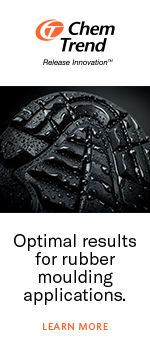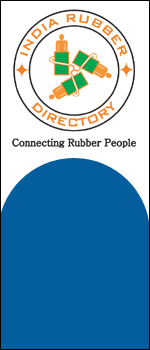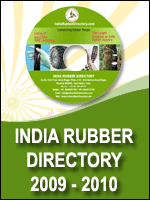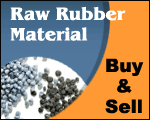New TPE Developments For Automotive Weather Seals
By Jurgen Glockler,
Advanced Elastomer System, N.V./S.A.
Introduction
Thermoplastic Elastomers (TPEs) are group of materials which bridge the gap
between thermoplastics and thermo set rubber(1) TPEs are sold a ready to use
materials in free flowing pellets and are available in hardness ranges from 35
shore A to 50 Shore D.
These materials exhibit significant higher average growth rates since their
introduction in the late 1970’s, early 1980’s. According to a market research
study conducted by the international Institute of Synthetic Rubber Producers in
1996, the consumption of TPEs in 2005 will be close to 2000 KMT worldwide.
Figure 1 shows the estimated growth with a split of North America and Europe.
The automotive market segment is the most important one for TPE materials.
Various engineering applications like blow moulded rack and pinion boots,
airducts, injection moulded seals and gaskets, plugs and grommets and car body
sealing systems – weatherseals are ideally suited to be designed around and
manufactured with high performance thermoplastic elastomers.
New requirements of automotive industry Original Equipment Manufacturers (OEMs),
like weight reduction, system cost reduction, design flexibility, colourability,
aesthetics and recyclability, favour the use of TPEs instead of traditional
thermoset rubber.
More and more OEMs are increasing their global activity and are designing,
sourcing and producing parts and vehicles in several world areas as a way of
improving their overall cost structure and profitability. This trend also
support the use of engineering thermoplastics produced according to worldwide
specifications, thereby ensuring global supply of an uniform material.
Even though TPEs are more expensive raw materials in comparison to thermoset
rubber compounds, finished parts or integrated systems with TPE as sealing
component offer cost saving potentials thanks to the more economical
thermoplastic processing technology.
Savings are realized through lower part weight, shorter cycle time in
processing, lower energy usage, less scrap, recyclability of scrap and
design/system, flexibility. On top of all these benefits, TPEs are
environmentally friendly materials.
Key Features of TPEs and classification
Almost all commercial TPEs have one feature in common: they are phase separated
systems, in which one phase is hard at room temperature, while another phase is
soft and elastomeric. The harder phase gives TPEs their strength and, when
melted in a thermoplastic machine, their processability. The soft phase gives
TPEs their elasticity and rubber performance².
The ability of TPEs to repeatedly become fluid when heated, and solid after
cooling, gives manufacturers the ability to produce, on conventional
thermoplastic machines, rubber-like articles. Scrap can usually be reground and
recycled key advantages for the manufacturer are using fast processing
thermoplastic equipment by feeding free flowing pellets, short cycle times, low
scrap rates, high automation, lower labour cost.
In the case of thermoset rubber replacement, the part is redesigned to leverage
and maximize the physical properties and processing characteristics of TPEs. In
the marketplace, many different families of TPEs are known. Therefore a
classification based on the chemistry is helpful.
TPEs can be classified into blockcopolymers and electromeric alloys. Figure 2
gives an overview of the materials included in these two categories.
The most important group of TPEs are thermoplastic vulcanisates, based on fully
crosslinked EPDM dispersed in a polypropylene (PP) matrix. Crosslinking of the
rubber phase in PP is usually done by dynamic vulcanization. Fine dispersion of
the elastomeric phase in the hard PP-phase results in an excellent balance of
rubberlike properties and good thermoplastic processing. Products based on fully
crosslinked EPDM are also known as EPDM-X + pp (TPE-V, TPV, EA) and are the
closest to be able of substituting classical thermoset rubber applications in
the automotive industry like the highly demanding weatherseals applications.
AUTOMOTIVE WEATHERSEALS- COMPONEMNTS
Weatherseals or car body sealing systems are used in the car as sealing elements
against water, air and noise damping, as sliding guide for movable windows. A
profile systems also provides an aesthetic and cosmetic aspect in-line with the
overall car design.
The most important elastomer for current thermoset rubber based weatherseals in
EPDM. Market studies from EPDM raw material suppliers estimate that around 400
KMT of EPDM is consumed for automotive weatherseal systems¹. In order to
understand which one of the various thermoset rubber weatherseal systems in the
car can be replaced by engineered TPEs, one has to classify all applications.
Figure 3 shows the different applications, split between static and dynamic. The
different, applications are listed on the X-axis from low to high complexity.
The lowest number of requirements apply to static sealing profiles, while the
best sealing performance and surface aspects are needed for dynamic
applications. Particularly for foamed profiles used as doorseals, trunkseals and
tailgate seals.
New material developments and fabrication technologies for TPEs, especially
EPDM-x+PP like santoprene® thermoplastic rubber, have been developed to meet all
requirements for these applications. The “All- TPE Weatherseal Vehicle” is now
is sight.
In the following chapters we will describe the status of the successful
penetration of these applications with engineered TPEs like santoprene®
thermoplastic rubber.
STATIC SEALING APPLICATIONS
Static weatherseals are applications which provide a constant sealing over the
lifetime of a car. The most important parameter is the constant stress over
time. In order to design the optimized profile geometry relaxation measurements
from TPEs are taken. With the introduction of flush glazing and zero gap designs
TPEs are preferred materials as trimseals and gapfillers.
The late eighties saw the commercialization of the first static sealing systems
made with santoprene rubber. Most of these are coextruded profiles, with a rigid
food out of PP and a sealing lip based on EPDM-X+PP. This combination is
economical in comparison to a thermoset rubber EPDM system because of the
effective synergy between a commodity plastic (PP) for the solid foot, and a TPE
for the sealing lip, in an optimized design. Figure 4 illustrates a typical
hard/soft static profile system.
Another main growth opportunity in static sealing systems in glass
encapsulation. For the encapsulation of glass, two processes can be used:
injection moulding or robotic extrusion. Both processes require speciality
products to ensure the best balance of processing, lowest glass breakage and
good sealing. Figure 5 shows the glass encapsulated quarter-light of the
Mercedes-M Class, which uses a santoprene rubber M 100 series grade.
Direct extrusion of profiles onto glass for large rear and front windows are
also commercial using a patented robotic extrusion system together with a
special great of Santoprene rubber. Sekurit Saint-Gobain. Deutschland GmbH & Co
K G has developed this technology in Co-operation with advanced Elastomer
Systems³. Its main advantage is the possibility to produce many different
profile designs including bulb seals and the robotic system allows to seal large
windows. Figure 6 shows two Windows with profiles based on a robotically
extruded special grade of santoprene rubber.
DYNAMIC SEALING APPLICATIONS
Dynamic sealing application are still mainly based on thermoset rubber EPDM
compounds developed and manufactured by thermoset rubber companies. Solid
(dense) belt line seals, glass run channels or sponge weatherseal systems like
door and trunkseals are the most critical applications with the highest level of
performance requirements. Dynamic sealing systems are characterized by a balance
of deformation and relaxation. A key variable of a good dynamic sealing profile
is the time in which a sealing lip is moving back to the original shape after
deformation. The classifclip is to measure its compression set at different
temperature.
Lab tests comparing engineerd TPEs with EPDM have shown that, especially at
higher temperatures like 70ºC to 100ºC, fully vulcanized TPEs (EPDM-X+PP) show
comparable compression set data. With the ageing of sulfur cured EPDM thermoset
rubber profiles as a well known weakness, engineered TPEs based on EPDM
represent an ideal alternative to overcome this deficiency of traditional
thermoset rubber systems.
In parallel measurements, it has been demonstrated that EPDM-thermoset rubber
profile design can be optimized around TPEs to achieve maximum performance for
dynamic weatherseals.
In a belt line seal application, the effect on compression set of varying the
design, with different types of santoprene rubber, has been studied4. Two
commercial grades with a hardness of 58 shore A and 67 shore A, and a
developmental grade with optimized elastic recovery have been evaluated. Figure
7 clearly shows that an optimised lip design incombination with an optimised
elastic recovery have been evaluated. Figure 7 clearly shows that an optimised
lip design incombination with at optimised elastic recovery product gives the
best result. These tests were after ageing at 70ºC, for 94 hours and after 1
hour relaxation before measurement.
Another interesting comparison of an EPDM rubber based belt line seal with lip
designs made with Santoprene rubber relates to ageing. Figure 8 shows the
permanent
deformation/set after ageing at 70ºC. This confirms the lab data, in that
profiles made with santoprene rubber have a more constant ageing behaviour after
6000 hours at 70ºC,, the plot indcates that EPDM ageing is by far the weakest,
less predictable or consistent over time.
This study clearly demonstrates that high performance engineered TPEs like
Santoprene thermoplastic rubber are ideal sealing materials for belt line seals.
Inner and outer belt line seals are designed as hard/soft combinations which
also points to the use of TPEs. The rigid (hard) piece provides structure for
ease of assembling and can be produced either from reinforced PP or ABS. The
sealing lip is based on a low modulus, high elastic TPE like Santoprene rubber.
Figure 9 shows the latest commercialization example in the case of the Ford
Focus. The sealing lip is covered with flock to ensure low friction for sliding
the window.
Belt line seals are the fastest growing TPE application in solid weatherseals
because of the obvious advantages of using thermoplastic materials. This is due
to the potential cost saving and by the elimination of recognized issues with
EPDM rubber profiles, like the difficulty to coextrude a very hard compound (>45
shore D) with a softer component (75 shore A), as well as the critical post
shrinkage of the profile.
Glass Run Channels are another application where TPEs add value. Most glass run
channels are made in one hardness around 75 shore A, and a low friction coating
layer is applied onto the thermoset rubber profile lips in contact with glass.
In addition, most systems have different designs and profile sections are
connected with corners, typically called corner mouldings. The main advantages
of using an All-TPE glass run channel are: cost savings through elimination of
complex low friction coating technology, corner moulding and weight reduction.
Current EDPM thermoset rubber coating systems for low friction are very
expensive and the scrap rate in most cases in higher than 10%. An All-TPE
alternative glass run channel system is based on a standard extrusion grade of
about 70 shore A and the low friction layer is coextruded.
AES has developed special low friction grades of Santoprene rubber which meet
the important balance of low coefficient of friction, good abrasion resistance
and good aesthetics. These speciality grades are designed to be coextruded. In
the mid-eighties, the first glass run channel based on santoprene rubber has
been commercialized on the Rover 800 and full functionality was demonstrated for
the full lifetime of the car. Figure 10 shows the latest commercialization
example of a glass run channel made with santoprene rubber which fulfills all
above mentioned features.
In 1998, Toyota approved santoprene thermoplastic rubber for this application
because of a weight saving of around 30% for a 4-door version compared to
traditional systems used and because of cost savings resulting from simplified
comer mouldings. The TPE glass run channel is promoted in the car advertising
brochure as a recyclable, environmentally friendly polyolefin-based material.
FOAMING
Physical foaming of Santoprene thermoplastic rubber has already been described
earlier in several publications¹. A basic patent to foam TPEs, by using water as
a blowing agent, has been patented by AES in 19915. At the same time, a suitable
high performance extrusion line to produce foamed sealing profiles was patented
by the German machine manufacturers Berstorff6. The combination of a special
foaming grade of santoprene rubber and special berstorff extruder allows to
produce foamed sealing profiles was patented by the German machine manufacturer
Berstorff6. The combination of a special Berstorff extruder allows to produce
foamed sealing profiles. The first water foamed hoodseal was commercialized by
Mitsubishi already in 19951,7. The key differences in the process of foaming a
TPE compared to EPDM thermoset rubber sponge has been reviewed and the process
analysis shows that the TPE Process offers clear recognized advantages1 .
The main advantage of a water foamed TPE is that the process starts with a fully
vulcanized TPE material and the only variable to control during extrusion is the
blowing/water foaming of the PP-matrix, which is done by injecting water in the
melt and by on line temperature control of the extruder. Building on the
excellent market feedback with the Mitsubishi hoodseal, Coextruded profiles have
now also been developed.
In March 1999, another breakthrough has been announced. In a joint press
release, Mitsubish and AES, together with Hiroshima Kasei, reported the first
tailgate/trunkseal commercialization based on Santoprene rubber8. Figure 11
shows the coextruded tailgate designed with a metal –reinforced solid foot and
the water foamed bulb to provide the sealing performance.
This is the first All –TPE tailgate seal worldwide. The application also uses a
new technology of simultaneously co-processing a solid santoprene rubber
substrate, a waterfoamed santoprene bulb seal and a light weight metal carrier.
The use of santoprene rubber results in a significant weight reduction,
increased recycling rates, improved part durability and part cost reductions.
Kinking does not occur thanks to the optimised design and the special metal
carrier. This part yields an expected 5-10% cost reduction versus an EPDM rubber
solution.
The system eliminates the need for compounding and curing lines, resulting in a
simpler, cleaner and faster manufacturing process. Recycling is easier and
|
Properties |
Standard |
TPE Profile |
EPDM Profile |
|
Density
Water Absorption, %
24 hrs @Rtatmospheric
pressure17kpa
Compression set, %
22hrs@RT
22hrs@70ºC
22hrs@100ºC
22hrs@-40ºC
Load Deflation,
N/100
mm@40%
Load aged Deflection
After 72 hrs@ 100ºC
Load Deflection
Change, %
Surface roughness, um |
ISO 1183
ISO R 62
ISO 815
ISO 3386
ISO 3386
ISO 4288 |
0.55
1
27
58
75
70
9.7
6.6
-32%
5.4 |
0.59
2
6
24
51
71
8.9
6.3
-30%
5.3 |
The profile fulfills the OEM requirement for an environmentally-friendly
production. Property have been measured and compared against those of a high
performance EPDM trunkseal, as listed in Fig. 12.
If we compared the measured tailgate seal properties of both options, we see
that the TPE system has been produced at same density as the high performance
EPDM profile. Water absorption measured at room temperature is good. Compression
set data show better values for EPDM thermoset rubber, as expected. However, at
-40ºC, boot profiles show the same level. One way to optimize compression set
for the TPE profile could be the reduction of its foam density.
Load deflection shows a good comparable level even after ageing. However, the
optimal load deflection must be designed by choosing a good balance between the
shape of the profile and foam density. Surface roughness is similar, but we know
that at a density of 0.59, EPDM is really at the limit of acceptable
performance, whereas the TPE profile density could be further reduced down to
0.3, while keeping good properties and surface.
This breakthrough development and commercialization demonstrates the potential
for TPEs in dynamic weatherseals. New innovative developments for secondary and
primary doorseals are now underway with the first commercialization expected in
1999. Special features like easy colouring and significant weight reduction in
the order of 1.2 kg/car will be resented with high performance EPDM-X+PP
materials9.
CONCLUSION AND OUTLOOK
OEMs have now recognized the potential of engineered thermoplastic elastomers.
Especially fully crosslinked EPDM-based alloys (EPDM-X+PP), like Santoprene®
thermoplastic rubber, are the preferred family of TPE materials because of their
best rubberlike properties, closests to EPDM thermoset rubber. Car manufacturers
are requesting further cost savings and innovations. Both criteria cannot be met
together by classical EPDM rubber systems. Weight reduction, colouring, design
flexibility, recyclability, plus global supply, are additional attributes which
clearly point to TPEs.
Advanced Elastomer Systems (AES) has formed a dedicated global team to support
the acceleration of TPE penetration in weatherseals. The translation of market
requirements into clearly defined product targets with our customers, product
development and fabrication/application technology support are the key focus
areas of the team to convert all weatherseals systems. Whether static or
dynamic, solid or foamed, to Santoprene rubber.
Based on the excellent track record in static hard/soft weatherseals, glass
encapsulation, glass run channels and belt line seals, engineered TPEs like
Santoprene rubber can now target highly demanding foamed coextruded weatherseals.
The “All-TPE Weatherseals Vehicle” will son be a reality and figure 3 shows that
doorseals are the only application yet to be commercialized. Developments are
underway. Prototyping has been done and, at the end of 1999, this last
validation step for santoprene rubber will be achieved.
Reference:
1. J. Glockler, Innovative TPE solutions in automotive weatherseal applications,
ETP Conference, ETP’98, Zurich, June 22-24 1998.
2. C.M. McMahan, Thermoplastic elastomers for automotive applications AES’
paper, Rubber Division, American Chemical Society, Indianapolis, Indiana, May
5-8, 19978.
3. AES, St. Gobain Sekurit/Gepoc-Robitic extrusion brochure. AES
Marketing/Communications Brochure, 1995
4. T. Burton, H.-J. Holz. Belt line seal development. AES Presentation, March
1999
5. US patent 5070111, Advanced Elastomer Systems L.P., December 3 1991.
6. J. Meike-Phsikalische Verschaumung von TPE mit dem Extrusionsverfahren. SKZ,
Wurzburg, 1996.
7. Technical paper presented by Mitsubishi Motor Company at the Society of
Automotive Engineers in Japan. AES with Hiroshima Kasei, May 17, 1995.
8. Mitsubishi selects santoprene® thermoplastic rubber for tailgate weatherseal
applications. AES press release, March 12, 1999.
9. Draftex- Foamed TPE Profiles. Advertisement, 1998.


























